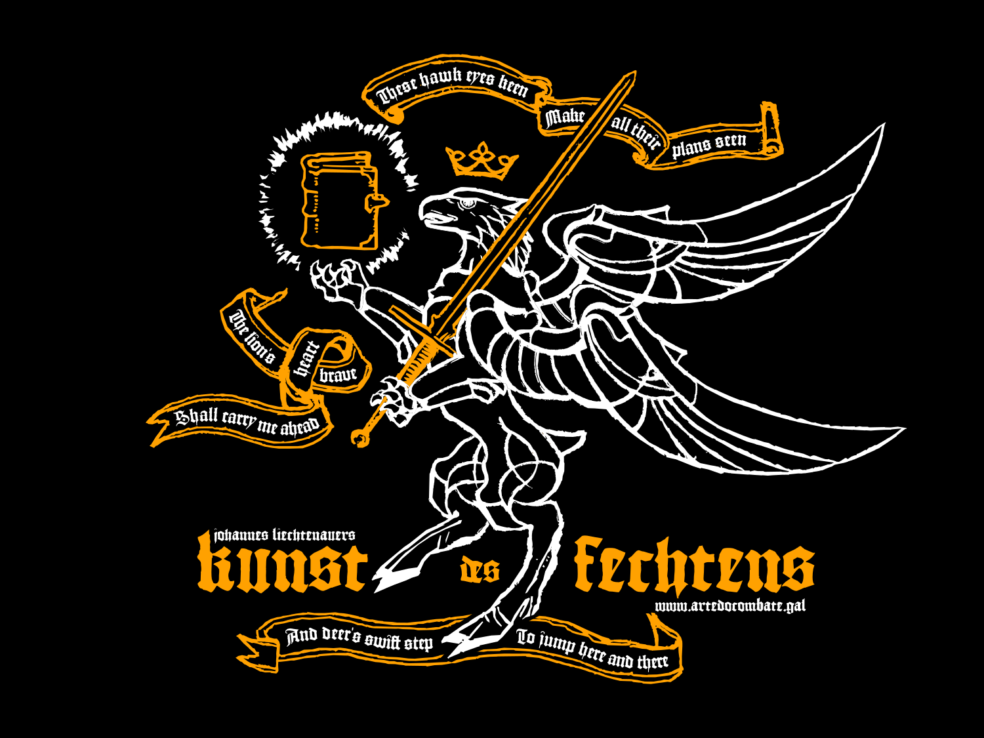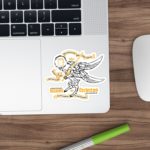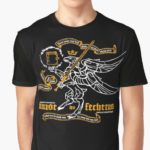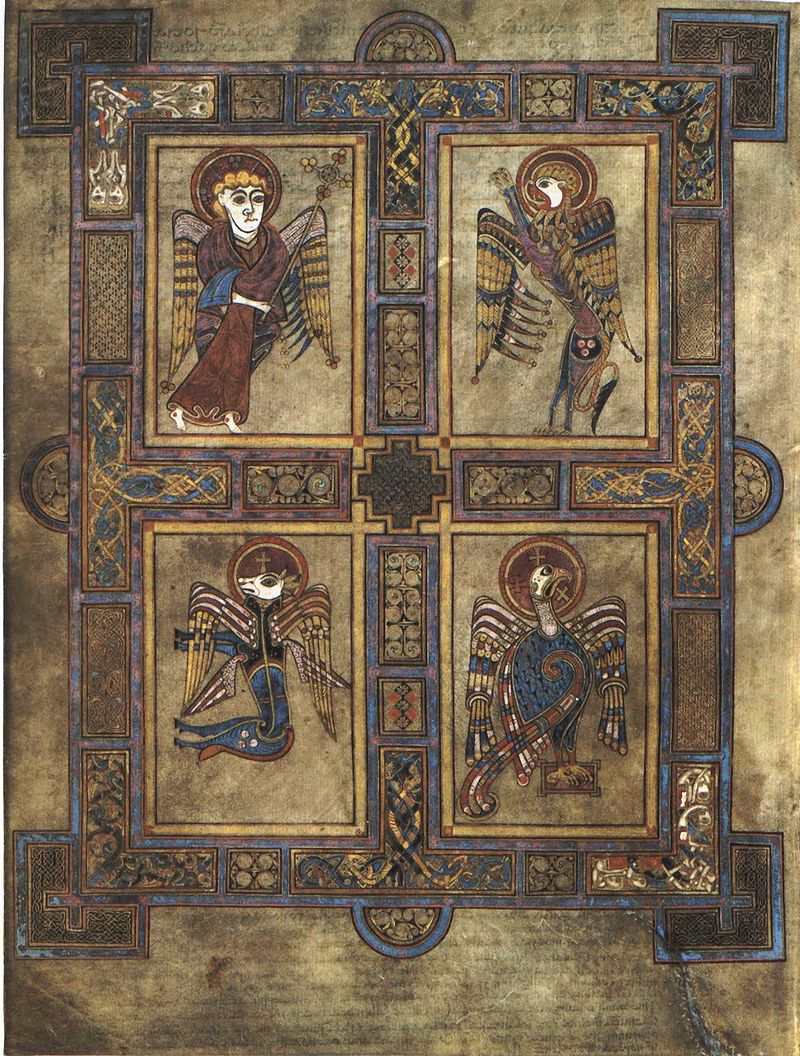[Existe uma versão galego-portuguesa deste artigo]
Here’s a new design, based on the «tetramorph of virtues» from Paulus Kal’s treatise: the keen eyes of the falcon, the brave heart of the lion, and the swift feet of the deer. It holds the sword and the book, as befits any historical fencer, and bears the crown of mastery — because isn’t that to what we strive?
The design is available in RedBubble in several formats, from t-shirts to displates, tapestries, stickers and notebooks — and while you are there, check our other designs too!
[If you fancy using it as a desktop wallpaper, grab the plain picture here.]Or, if you are yet unconvinced, you can go on reading an admitedly too long exposition on this beast’s symbolism.
The original
Paulus Kal was a master of the Art which wrote near the end of the XV century one significant Kunst des Fechtens treatise — between other cool stuff, he listed there the «Fellowship of Liechtenauer»: the names of several associated masters of the Art.

The first pages of these manuscripts1 display an evocative image which represents the virtues we should cultivate:
- falcon eyes = foresight, intelligence
- lion heart = courage, initiative
- deer feet = agility, measure
This is made explicit in the text around it:
[I have eyes like a hawk / so I will not be fooled //ich hab augen als ein valk
das man mich nit beschalk
ich hab hercz als ein leb
das ich hin czu streb
ich hab füs als ein hint
das ich darzw und dauon spring
I have a heart like a lion / so I go on forward //
I have feet like a deer / to spring back and forth]
Which could be more loosely translated, on behalf of rhyme, as:
Mine hawk eyes keen
Make their plans seenThe lion’s heart brave
Then carries me aheadAnd deer’s swift step
To jump here and there
Deepening in symbolism
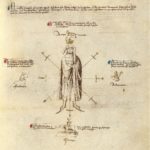
There’s a similar image in Fiore de’i Liberi’s Flos Duellatorum treatises. He was partial to four virtues: prudentia (lynx eyes), celeritas (tiger arms), audatia (lion heart) and fortitudo (elephant legs).
Paulus Kal’s choice of animals, however, doesn’t strike as casual. Firstly, because this choice represents stylistic differences between Kunst and Flos: the swift feet of the deer versus the strong legs of the elephant, plus the lack of references to strength.
Strength, in Kunst des Fechtens, isn’t generally emphasized as a virtue. GNM HS 3227a explicitly says: «And this is why the Art of Liechtenauer is a true Art: because sooner will you gain victory through skill than through force alone — if this was not so, then who was strong would always win. And then, what sense would learning the Art make?» (My translation — If you are curious, we have a galician/portuguese translation and interpretation of 3227a available for purchase here).
Going deeper in symbolism, these three animals might represent the three fencing guilds which throughout time existed in the Holy Roman Empire:
- Winged Lion = Marxbrüder = Saint Mark
- Eagle [Falcon] = Federfechter = Saint Paul
- Ox [Deer] = Lukasbrüder = Saint Luke
- Federfechter
- Marxbrüder
This symbolism is confirmed in the coats of arms for these guilds. The Winged Lion of St. Mark forms part of the Marxbruder heraldry, and likewise does the winged griffin appear in the Federfechter’s. There’s no recorded arms for the Lukasbrüder (and references to them are scarce indeed) but attributin the Ox to them is only reasonable at this point.2
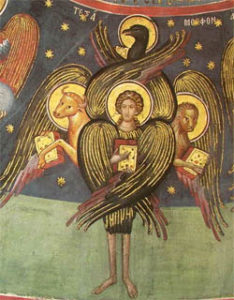 And Matthew was, of course, the fourth evangelist, whom in contrast to the other three is represented solely by the human figure. There was not, as far as we know, a fencing guild associated to St. Matthew, but one might infer that, by exclusion, he is in charge of all the «non aligned» or «common» fencers out there.
And Matthew was, of course, the fourth evangelist, whom in contrast to the other three is represented solely by the human figure. There was not, as far as we know, a fencing guild associated to St. Matthew, but one might infer that, by exclusion, he is in charge of all the «non aligned» or «common» fencers out there.
By combining these three animals in human form, Paulus Kal is effectively producing a tetramorph — a critter which in biblical terminology is a joint representation of the four evangelists. In the context of the Kunst des Fechtens meta-reading, this would represent a gathering of virtues from all four «guilds» or kinds of fencers. Unsurprisingly, in pure aristotelian style, he is suggesting that the truth of the Liechtenauer’s word lies not in any of the factions, but in picking the best out of each.
This appropriation of the four evangelists is not anecdotal in the Kunst des Fechtens repertoire of tricks: there is evident inspiration in christian formalism throughout its collective narrative. It shouldn’t come as a surprise — christian teology, mythos and rethoric was omnipresent back in the day.
For example: Liechtenauer’s figure has clear mesianic dimensions. He is the one who brings the Word in the Zettel (an art which «he didn’t invent, because it already existed») not unlike Moses brings the Word of God down from Mount Sinai. He teaches that Word to his disciples, who procceed to spread it throughout the world — the Fellowship of Liechtenauer has more than a passing resemblance to the christian apostles3.
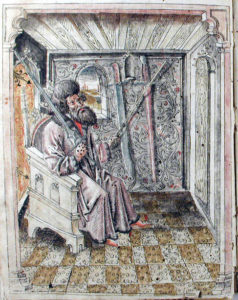
Revelations 4 describes a throne where the Creator sits dressed in red, guarded by the «four living beings»: eagle, lion, ox and human. Is it coincidence that the only image we have that (presumably) represents Johannes Liechtenauer is of an old master dressed in red sitting on his throne?
Is it also a coincidence that the main four stems of early Kunst des Fechtens literature are four, just like the four gospels? Indeed, the oldest texts we can trace are the glossæ by the anonymous 3227a author and those attributed to Sigmund Ringeck, Peter vom Danzig and Martin Huntfeltz (all in Kal’s fellowship list).
The heart of the Art, as 3227a insists once and over again, rests in the Holy Trinity of Schwach/Stark/Indes — or in Vor/Indes/Nach, in other reading. Three are also the ways of wounding with a sword — the Drey Wunder, thrust, cut and slice.4
There are many other correspondences betwen christian formalism and KdF literature which probably deserve a separate article. As stated above, christian culture was very present when these texts were written, and therefore it would offer a recognisable rethoric. This would help in many ways, not in the least in providing credibility by way of similarity, as well as making its teachings easy to memorise and recall.
A modern interpretation
 While the original images from Paulus Kal’s treatises have an inherently medieval quality to them, they too are distant from modern day aesthetics and ideas of harmony. To try and update this idea, I took elements from representations of the evangelic animals in stained glass decorations of cathedrals and palaces.
While the original images from Paulus Kal’s treatises have an inherently medieval quality to them, they too are distant from modern day aesthetics and ideas of harmony. To try and update this idea, I took elements from representations of the evangelic animals in stained glass decorations of cathedrals and palaces.
The original tetramorph bore already a sword, which is the main instrument of this Art. I chose to equip it here with a design picked from the pages of the Goliath fechtbuch, whose images are particularly nice and good. This weapon in particular is interesting because while it is depicted as stabbing through an opponent (folio 36r), so presumably sharp, it still sports a Schild, like the ones we associate with Fechtschwerten.
I chose to have the beast hold a book in its spare hand, almost as if reading it. This is a hark to our present historical martial arts community. We rely totally in the existence of these precious fight-books to learn and practice these lost arts, and unsurprisingly the sword-and-book is a recurrent combination in many HEMA club logos.
Straying a bit from proper KdF imagery, I stole Fiore’s usage of the crown as a symbol for mastery to complete the design. Because don’t we all strive for it?
Remember to check RedBubble to get your merchandise with this design and others!


